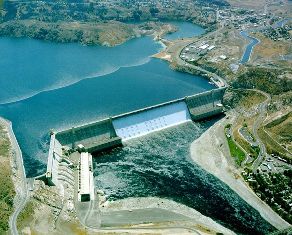| Facts: Columbia River Treaty
Columbia River Treaty
2014/2024 Review
What is the Treaty?
· International agreement between Canada and the United States
· Cooperative development and operation of water resources of Columbia River Basin
· For flood control and power
Columbia River Treaty: Getting Started
· 1909—Boundary Waters Treaty established principles and procedures affecting boundary waters and created an International Joint Commission
· 1948—Memorial Day flood, over 50 deaths and destruction of Vanport, Oregon's 2nd largest city
· 1959—Treaty negotiations begin
· 1961—Treaty signed and ratified by U.S. Senate
· 1964—Treaty ratified by Canada and implemented
Columbia River Basin
· Fourth largest river in North America (by volume)
· Average annual flow at the mouth is about 198 million acre feet (maf)
· Canada has 15% of basin area
o 30% of 134 maf average annual flow at The Dalles
· 50% of flows at The Dalles during worst flood (1894) came from across Canadian border
Power
· Columbia River is largest hydroelectric producing river on continent
· Provides over 40% of total electricity produced in British Columbia, Canada, and about 30% for Pacific Northwest
· Under Treaty, U.S. must deliver electric power to Canada equal to one-half estimated U.S. power benefits, or "Canadian Entitlement", from operation of Canadian Treaty storage
Flood Control
· 8.45 Maf of storage (recently increased to 8.95 Maf due to Arrow—Mica re-allocation) under a flood control operating plan which specifies assured reservoir drafts
· Plus all additional storage on an on-call basis (as requested and paid for)...this has never been used to date
· As dams completed, U.S. paid Canada $64.4 million for one-half present worth of expected future U.S. flood damages prevented from 1968 through 2024
· Unconditional guarantee by Canada of 8.95 Maf of flood control was purchased only through 2024
Why Treaty Review?
· Provision of purchased flood control space in Canadian Treaty projects expires in 2024
· While Treaty has no specified end date, allows Canada or U.S. option to terminate most of provisions of Treaty on or after September 16th, 2024
· 10 years advance written notice is required for termination
· Operations under Treaty are complex and affect millions of people
What Does Review Involve?
· U.S. Entity is taking phased approach to studying Treaty and issues related to future
· Phase 1 of 2014/2024 Columbia River Treaty Review was joint effort between U.S. and Canadian Entities
· Phase 1 was initial modeling and analysis phase to provide fundamental information about post-2024 conditions with and without current Treaty and only from limited perspective of power and flood control
· Phase 1 report was released in July of 2010
· Following Phase 1, U.S. Entity and U.S. Department of State will work together to coordinate next steps and additional phases, including developing appropriate level of consultation and involvement with other U.S. parties, such as affected states, tribes and other stakeholders
< Back
|
